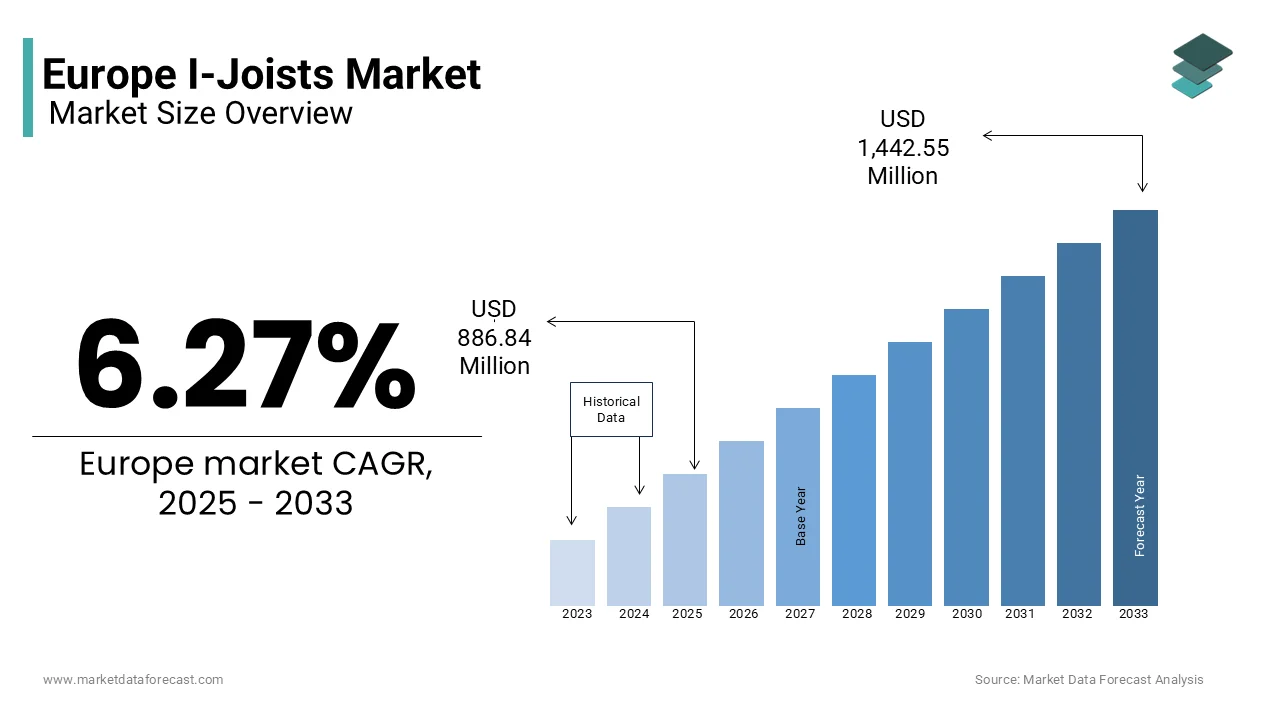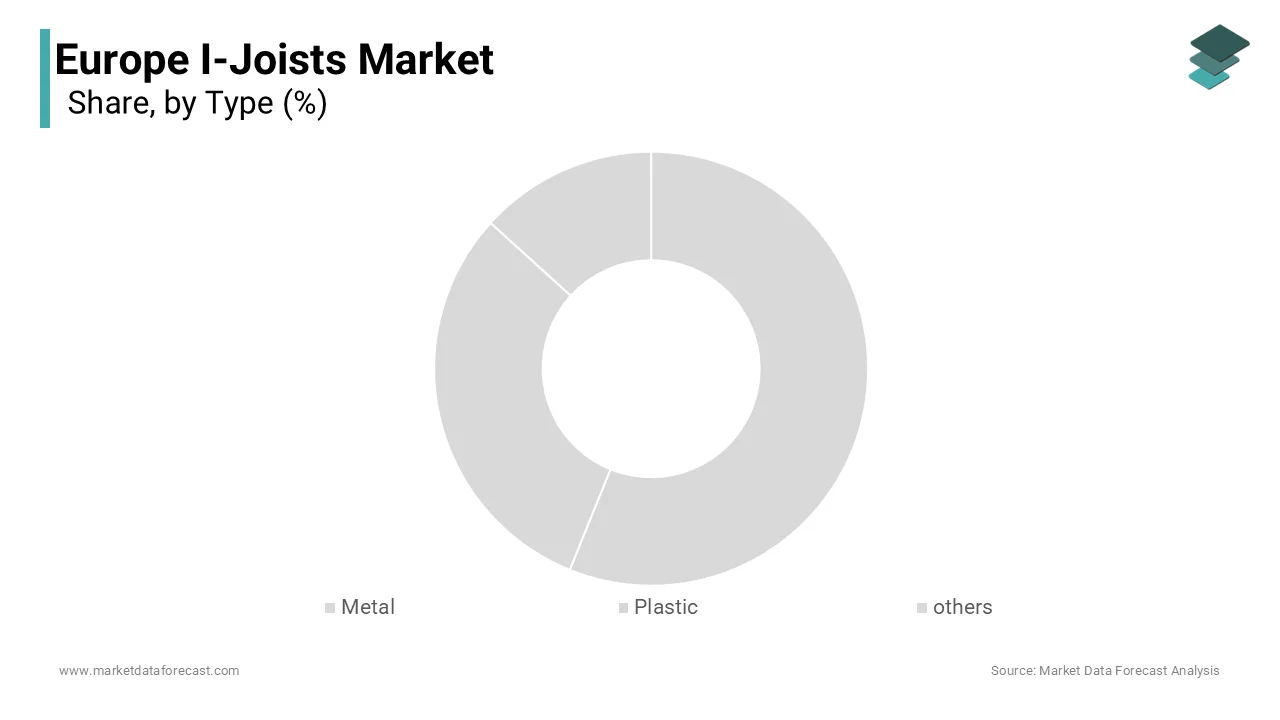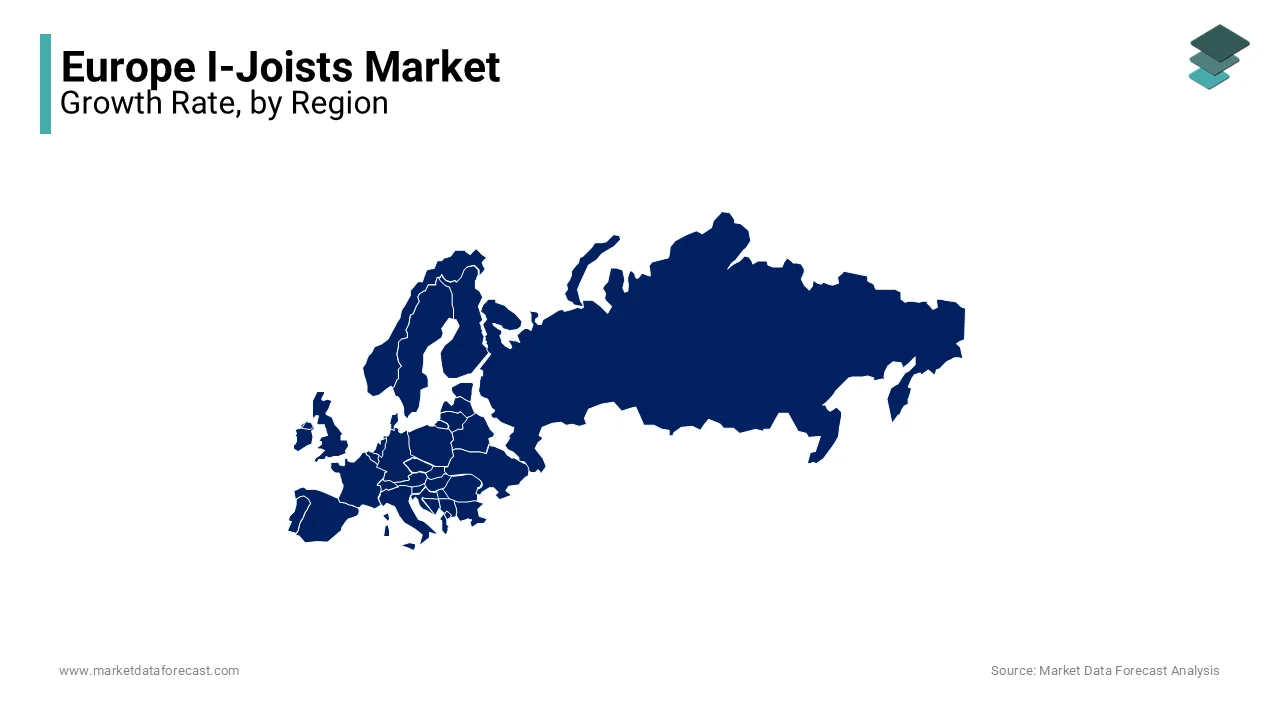Europe I-Joists Market Size, Share, Trends & Growth Forecast Report By Type (Metal, Plastic, Others), Application, End-Use, and Country (UK, France, Spain, Germany, Italy, Russia, Sweden, Denmark, Switzerland, Netherlands, Turkey, Czech Republic & Rest of Europe), Industry Analysis From 2025 to 2033
Europe I-Joists Market Size
The Europe I-Joists market size was valued at USD 834.52 million in 2024. The European market is estimated to be worth USD 1,442.55 million by 2033 from USD 886.84 million in 2025, growing at a CAGR of 6.27% from 2025 to 2033.

I-joists, engineered wood or metal structural components designed for superior load-bearing capacity and dimensional stability, are widely used in construction projects across Europe. These products offer significant advantages over traditional lumber, including reduced weight, enhanced strength, and improved consistency, making them ideal for residential, commercial, and industrial applications. According to the European Construction Industry Federation, the demand for i-joists in Europe grew by 9% in 2022, driven by increasing investments in sustainable building practices and lightweight construction materials. The European Commission's Green Deal initiative emphasizes reducing carbon footprints in construction, further boosting the adoption of eco-friendly materials like i-joists. Additionally, according to Eurostat, investments in advanced construction technologies exceeded €50 billion in 2022, creating a favorable environment for i-joist adoption. Despite challenges such as fluctuating raw material prices and supply chain disruptions, the market continues to expand, supported by advancements in manufacturing technologies and growing consumer awareness of energy-efficient building solutions. This report explores the key drivers, restraints, opportunities, and challenges shaping the European i-joist market, while also providing a detailed segmental analysis by type, application, end-use, and regional breakdown.
MARKET DRIVERS
Rising Demand for Lightweight Construction Materials
The escalating demand for lightweight construction materials serves as a major driver for the European i-joist market. According to the European Construction Products Regulation, over 60% of new construction projects in Europe prioritize materials that reduce structural weight while maintaining high performance. I-joists, with their superior strength-to-weight ratio, are extensively used in flooring, roofing, and wall systems, enabling faster installation and reducing labor costs. The European Investment Bank reports that investments in lightweight construction technologies reached €30 billion in 2022, further amplifying demand for i-joists. Additionally, the European Technology Platform for Sustainable Chemistry highlights the increasing use of i-joists in green building projects, underscoring their critical role in achieving sustainability goals.
Growing Adoption in Residential Construction
The growing adoption of i-joists in residential construction represents another significant driver for the European market. According to the European Housing Federation, the demand for affordable and energy-efficient housing grew by 12% in 2022, driven by urbanization and population growth. I-joists are extensively used in residential projects due to their ability to span long distances without additional support, providing architects and builders with greater design flexibility. The European Commission's Horizon Europe program emphasizes innovation in sustainable housing solutions, further boosting demand for i-joists. Additionally, the European Investment Bank projects that investments in residential construction will reach €70 billion by 2030, underscoring the critical role of i-joists in enabling innovative and cost-effective building solutions.
MARKET RESTRAINTS
High Initial Costs
High initial costs associated with i-joists represent a significant restraint for the European market. According to the European Federation of Civil Engineering Contractors, the cost of incorporating i-joists into construction projects is approximately 20-30% higher than traditional lumber, limiting their affordability for small-scale projects. The European Construction Industry Federation notes that over 60% of contractors cite affordability as a primary barrier to adopting i-joists, particularly in low-budget infrastructure developments. Additionally, fluctuations in raw material prices, particularly engineered wood and steel, exacerbate this issue. According to the European Metals Association, the cost of these materials surged by 25% in 2022 due to supply chain disruptions, impacting profit margins. These financial barriers not only hinder market growth but also constrain investments in scaling production capacities and expanding product portfolios.
Limited Awareness Among Small-Scale Builders
Limited awareness among small-scale builders regarding the benefits of i-joists represents another critical challenge for the European market. According to the European Federation of Civil Engineering Contractors, less than 40% of small and medium-sized enterprises (SMEs) in Europe utilize i-joists in their construction projects, creating a significant knowledge gap. The European Commission highlights that over 50% of SMEs struggle to adopt advanced materials due to insufficient training and education. Furthermore, the European Investment Bank reports that investments in workforce training programs for i-joist technologies remain insufficient, with only €5 billion allocated annually across the region. This lack of awareness not only slows the adoption of i-joists but also limits innovation and technological advancement. Addressing this challenge requires coordinated efforts between governments, educational institutions, and industry stakeholders to develop comprehensive awareness initiatives.
MARKET OPPORTUNITIES
Advancements in Sustainable Building Technologies
Advancements in sustainable building technologies present a lucrative opportunity for the European i-joist market. According to the European Commission's Green Deal initiative, over 30% of European construction projects are transitioning to eco-friendly materials, driving demand for i-joists in residential and commercial applications. The European Investment Bank reports that investments in sustainable construction technologies exceeded €50 billion in 2022, creating a favorable environment for i-joist adoption. Additionally, the European Technology Platform for Sustainable Chemistry highlights the increasing use of i-joists in retrofitting and renovation projects, further amplifying demand. This opportunity positions i-joists as a critical enabler of Europe's sustainability goals, aligning with the region's commitment to reducing carbon footprints.
Expansion into Commercial Construction
The growing focus on commercial construction offers another promising opportunity for the European i-joist market. According to the European Real Estate Council, the demand for office spaces, retail outlets, and industrial facilities grew by 15% in 2022, driven by economic recovery and urbanization. I-joists are extensively used in commercial projects due to their ability to provide large open spaces without compromising structural integrity. The European Investment Bank projects that investments in commercial construction will reach €80 billion by 2030, further accelerating this trend. Additionally, the European Commission's Circular Economy Action Plan supports the development of sustainable commercial buildings, amplifying the need for advanced materials like i-joists. This opportunity underscores the immense potential for market expansion in the commercial construction sector.
MARKET CHALLENGES
Supply Chain Disruptions
Supply chain disruptions pose a significant challenge to the European i-joist market, exacerbated by logistical bottlenecks and geopolitical tensions. According to the European Maritime Safety Agency, shipping delays increased by 25% in 2022, affecting the timely delivery of raw materials and finished products. The Russia-Ukraine conflict has further disrupted the supply of key raw materials such as engineered wood and steel, which account for nearly 70% of i-joist production expenses. The European Federation of Civil Engineering Contractors reports that imports of certain raw materials declined by 40% in 2022, leading to shortages and price spikes. These disruptions not only elevate operational costs but also hinder production schedules, impacting market stability. According to Eurostat, over 30% of manufacturers experienced production halts in 2022 due to supply chain challenges, underscoring the severity of this issue.
Regulatory Scrutiny and Compliance Costs
Regulatory scrutiny and compliance costs surrounding the use of construction materials pose another critical challenge to the European i-joist market. According to the European Chemicals Agency, i-joists must comply with strict environmental and safety regulations under the REACH Directive, which mandates rigorous testing and documentation to ensure compliance. The European Commission reports that over 40% of i-joist projects face delays due to these stringent requirements, impacting time-to-market. Additionally, the European Federation of Civil Engineering Contractors highlights that compliance costs for i-joist manufacturers have risen by 20% over the past three years, limiting affordability for SMEs. These regulatory hurdles not only hinder market growth but also deter new entrants, constraining overall expansion.
REPORT COVERAGE
|
REPORT METRIC |
DETAILS |
|
Market Size Available |
2024 to 2033 |
|
Base Year |
2024 |
|
Forecast Period |
2025 to 2033 |
|
CAGR |
6.27% |
|
Segments Covered |
By Type, Application, End-Use, and Region |
|
Various Analyses Covered |
Global, Regional, & Country Level Analysis; Segment-Level Analysis; DROC; PESTLE Analysis; Porter’s Five Forces Analysis; Competitive Landscape; Analyst Overview of Investment Opportunities |
|
Regions Covered |
UK, France, Spain, Germany, Italy, Russia, Sweden, Denmark, Switzerland, Netherlands, Turkey, Czech Republic, Rest of Europe |
|
Market Leaders Profiled |
Metsä Wood, Steico SE, Stora Enso Oyj, Binderholz GmbH, Rotho Blaas SRL, Wienerberger AG, Norbord Inc., Södra Wood Ltd., Egger Group, and EGGER Wood Products LLC, and others. |
SEGMENTAL ANALYSIS
By Type Insights
Metal i-joists dominate the European market, commanding a market share of approximately 55%, according to the European Construction Industry Federation. This leadership is attributed to their superior strength, durability, and resistance to environmental degradation, making them ideal for commercial and industrial applications. The European Commission reports that over 60% of metal i-joists consumed in Europe are utilized in large-scale construction projects, reflecting their widespread adoption. Additionally, the European Investment Bank highlights that investments in advanced metal fabrication technologies reached €20 billion in 2022, creating a favorable environment for metal i-joist adoption. The versatility and reliability of metal i-joists ensure their sustained dominance in the market, particularly for applications requiring compliance with stringent performance standards.

Plastic i-joists emerge as the fastest-growing segment, with a projected CAGR of 12% from 2023 to 2030, as per the European Federation of Civil Engineering Contractors. This rapid growth is fueled by their increasing adoption in lightweight and eco-friendly construction projects, where they provide superior thermal insulation and moisture resistance. The European Investment Bank reports that investments in sustainable construction technologies will reach €30 billion by 2030, further accelerating this trend. Additionally, the European Commission's Green Deal initiative supports the development of sustainable building solutions, amplifying the need for plastic i-joists. This trend positions plastic i-joists as a key driver of innovation in the European market.
By Application Insights
Floors represent the largest application segment in the European i-joist market, holding a market share of approximately 45%, according to the European Construction Industry Federation. This leadership stems from the extensive use of i-joists in residential and commercial flooring systems, where they provide superior load-bearing capacity and dimensional stability. The European Commission reports that over 60% of i-joists consumed in Europe are utilized in flooring applications, reflecting their widespread adoption. Additionally, the European Investment Bank highlights that investments in advanced flooring technologies reached €25 billion in 2022, underscoring the critical role of i-joists in supporting this growth. The versatility and reliability of i-joists ensure their sustained dominance in the flooring sector.
Roofs emerge as the fastest-growing application segment, with a projected CAGR of 10% from 2023 to 2030, as per the European Federation of Civil Engineering Contractors. This rapid growth is driven by the increasing demand for durable and weather-resistant roofing solutions, where i-joists provide superior strength and flexibility. The European Investment Bank projects that investments in advanced roofing technologies will reach €20 billion by 2030, further accelerating this trend. Additionally, the European Commission's Green Deal initiative supports the development of sustainable roofing solutions, amplifying the need for advanced materials like i-joists. This trend positions roofs as a key driver of innovation in the European market.
By End Use Insights
Residential construction represents the largest end-use segment in the European i-joist market, holding a market share of approximately 60%, according to the European Housing Federation. This leadership stems from the extensive use of i-joists in single-family homes, apartments, and townhouses, where they provide superior strength, flexibility, and ease of installation. The European Commission reports that over 70% of i-joists consumed in Europe are utilized in residential projects, reflecting their widespread adoption. Additionally, the European Investment Bank highlights that investments in residential construction technologies reached €50 billion in 2022, underscoring the critical role of i-joists in supporting this growth. The versatility and reliability of i-joists ensure their sustained dominance in the residential construction sector.
Commercial construction emerges as the fastest-growing end-use segment, with a projected CAGR of 11% from 2023 to 2030, as per the European Real Estate Council. This rapid growth is driven by the increasing demand for office spaces, retail outlets, and industrial facilities, where i-joists provide large open spaces without compromising structural integrity. The European Investment Bank projects that investments in commercial construction will reach €80 billion by 2030, further accelerating this trend. Additionally, the European Commission's Circular Economy Action Plan supports the development of sustainable commercial buildings, amplifying the need for advanced materials like i-joists. This trend positions commercial construction as a key driver of innovation in the European market.
REGIONAL ANALYSIS
Germany leads the European i-joist market, holding a market share of approximately 25%, according to the German Construction Industry Federation. This prominence is attributed to the country's robust construction sector and strong emphasis on sustainable building practices. The German Federal Ministry for Economic Affairs and Climate Action reports that over 60% of residential and commercial projects in Germany utilize i-joists, reflecting the region's leadership in adopting advanced materials. Additionally, Germany's strategic investments in green construction create a favorable environment for market growth, aligning with the European Green Deal initiative.

France ranks second, with a market share of approximately 18%, as per the French Ministry of Housing. The country's strong presence in residential and commercial construction drives i-joist adoption. The French Environmental Protection Agency highlights the growing use of i-joists in sustainable housing projects, while the French Construction Federation reports a 15% annual increase in their use in commercial buildings. Furthermore, France's focus on sustainability boosts the use of eco-friendly solutions, underscoring the segment's importance.
The UK holds a market share of approximately 15%, according to the UK Construction Products Association. The country's thriving construction sector, coupled with its robust housing and infrastructure projects, drives i-joist demand. The UK government's commitment to sustainable construction supports the use of high-performance i-joists, ensuring steady market growth. Additionally, the UK's investment in advanced construction technologies amplifies its leadership in producing eco-friendly i-joist solutions, aligning with global trends toward sustainability.
Italy accounts for approximately 12% of the market, as per the Italian Construction Industry Federation. The country's extensive residential and commercial projects rely heavily on i-joists for enhancing structural integrity and design flexibility. Italy's leadership in sustainable construction amplifies demand for eco-friendly solutions. Furthermore, the Italian government's focus on environmental regulations aligns with the growing adoption of advanced i-joists, further supporting market growth.
Spain holds a market share of approximately 10%, according to the Spanish Ministry of Public Works. The country's construction and infrastructure projects are significant consumers of i-joists. Spain's emphasis on sustainable building utilizes i-joists extensively in eco-friendly formulations. Additionally, the Spanish Ministry for Ecological Transition highlights the country's commitment to circular economy initiatives, driving demand for sustainable materials like plastic i-joists.
KEY MARKET PLAYERS
The major key players in Europe I-Joists market are Metsä Wood, Steico SE, Stora Enso Oyj, Binderholz GmbH, Rotho Blaas SRL, Wienerberger AG, Norbord Inc., Södra Wood Ltd., Egger Group, and EGGER Wood Products LLC, and others.
MARKET SEGMENTATION
This research report on the Europe I-Joists market is segmented and sub-segmented into the following categories.
By Type
- Metal
- Plastic
- Others
By Application
- Architecture
- Floors
- Roofs
- Bridge
- Others
By End-Use
- Residential
- Commercial
By Country
- UK
- France
- Spain
- Germany
- Italy
- Russia
- Sweden
- Denmark
- Switzerland
- Netherlands
- Turkey
- Czech Republic
- Rest of Europe
Frequently Asked Questions
1. What is the projected size of the Europe I-joist market by 2033?
The European market is estimated to be worth USD 1,442.55 million by 2033.
2. What are the primary drivers of the Europe I-joist market?
The market is driven by advancements in construction technology, increasing demand for sustainable construction materials, and stringent building regulations aimed at improving energy efficiency and reducing carbon footprints.
3. Which regions within Europe are experiencing significant growth in the I-joist market?
Eastern Europe, particularly countries like Poland, the Czech Republic, and Hungary, are witnessing rapid growth due to increasing construction activities and economic development.
Access the study in MULTIPLE FORMATS
Purchase options starting from $ 2000
Didn’t find what you’re looking for?
TALK TO OUR ANALYST TEAM
Need something within your budget?
NO WORRIES! WE GOT YOU COVERED!
Call us on: +1 888 702 9696 (U.S Toll Free)
Write to us: [email protected]